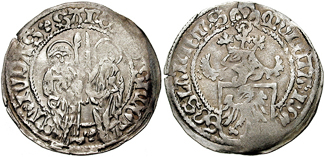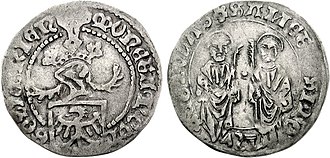Farmer's egg
The Bauerngroschen , also Burgroschen ( Low German Buur 'Bauer' ), is a groschen that was minted in the imperial city of Goslar from 1477 to at least 1490 and was in circulation until the 16th century. On the front it shows a coat of arms with an imperial eagle under a helmet with a crown and on the back the saints Simon and Jude . The two apostles were due to the generally poor expression of coins interpreted by the people as pawns. This is how the coin name came about.
Coin description
The peasant groschen minted in the imperial city of Goslar contained 2.2 g of fine silver with a rough weight of 2.92 g at the end of the 15th century . The groschen was worth 12 Goslar or Hildesheim pfennigs . At a coinage convention in 1490 it was decided that a gulden should be worth 13 Goslarian peasant groschen to 12 pfennigs.
front
The obverse shows the helmeted city shield of the imperial city of Goslar with a simple imperial eagle, above a crown with a plume.
- Inscription: MONETA NOVA - GOSLARIEN (sis) (in monk script) - in the picture above with GOSLARIENS
- Translation: Goslar's new coin
back
Left the apostle Judas with a club , right the apostle Simon with a saw .
- Inscription: SANCTVS SIMON - ET IVDAS
- Translation: Saints Simon and Jude
Coin-historical connections
The two saints Simon Zelotes and Judas Thaddäus, who were interpreted by the population as farmers on the late medieval silver groschen Goslar, belong to the twelve apostles of Jesus Christ according to Christian tradition . According to one version of the way of death, Simon was sawed up and Judas was slain with a club. The saw as an attribute of Simons, which is held like a stick, can be recognized on the farmer's groschen . The club of Judas on the penny is sometimes referred to as a stick. Simon is considered the patron saint of woodcutters , while Judas did not have any special protective tasks for a long time, because, as it is said, he was confused with Judas , who betrayed Christ for 30 pieces of silver . "The unemployed St. Judas", says Hans Herrli, "therefore has enough time and leisure to devote himself to unusually difficult and time-consuming problems."
According to Karl Christoph Schmieder , the peasant groschen were minted in the imperial city of Goslar. But he explains that the apostles Simon and Jude indicate that
“That these groschen were not minted […] by the city council, [but] by the free imperial monastery of St. Simon and Judas in Goslar. They are expressed badly enough (pronounced), that [is] the haloes even wol for caps, their [...] Reiser for cudgel and even Harz can watch farmers, and therefore there is the old designation Bauer dime. "
However, Schmieder gives the minting time of the groschen to the time around 1350, which contradicts the current information (minted from 1477).
The Scholars' Association (1839), Leitzmanns Numismatic Newspaper (1842) and KG Ritter von Schultheß-Rechberg (1846) and a. also name the Reichsstift as minting authority for these groschen. Accordingly, they belonged “probably more correctly” to the monastery of that name and not to the city of Goslar.
Both the imperial city of Goslar and the Pfalzstift St. Simon and Judas had access to the rich silver mines of the Rammelsberg. Currently, the municipal mint of Goslar is usually given as the mint. Sometimes the city is mentioned as a coin stand .
Note The municipal mint of Goslar, first mentioned in a document in 1331, was active until 1764. She got her silver from the nearby Rammelsberg .
Whether the groschen with the popular coin name Bauerngroschen was minted by the city council or the free imperial palace of St. Simon and Judas is differently stated. What is certain is that the farmer's groschen were minted in Goslar. Early city coins are the so-called Matthiaspfennige ( bracteates ), minted since around 1436 , the Matthiasgroschen also called Matthier (since around 1470/71), then the Mariengroschen and the Körtlinge, which is a type of grosch (= short coin) that was minted from 1552 to 1555 . Taler had the city of Goslar minted from 1531.
See also
- Jacob's Redeemer from the Goslar or Zellerfeld mint
- Air pump coins from the Goslar or Zellerfeld mints
- Schmalkaldic federal thaler from the federal mint in Goslar
- Lichttaler from the Goslar Mint
- Truth thaler from the Goslar mint
- Mosquito dollars from the mint Osterode am Harz
literature
- Heinz Fengler, Gerd Gierow, Willy Unger: transpress Lexikon Numismatics , Berlin 1976
- Helmut Kahnt: The large lexicon of coins from A to Z , Regenstauf 2005
- Wolfgang Leschhorn : Brunswick coins and medals. 1000 years of coin art and monetary history in the city and country of Braunschweig. , Appelhans-Verlag 2010, ISBN 978-3-941737-22-8 , pp. 88-91.
- Karl Christoph Schmieder : Concise dictionary of the entire coinage ... , Halle and Berlin 1811
- Bernd Schneidmüller : The Goslar Palatinate Monastery of St. Simon and Judas and the German monarchy in the Staufer period , Hanover 1993
- Friedrich von Schrötter , N. Bauer, K. Regling, A. Suhle, R. Vasmer , J. Wilcke: Dictionary of Coin Studies , Berlin 1970 (reprint of the original edition from 1930)
Individual evidence
- ↑ Bayerisches Münzkontor: minted at least until 1490, in circulation until the 16th century.
- ↑ Friedrich von Schrötter…: Dictionary of Coin Studies …, p. 64.
- ↑ Heinz Fengler, ...: transpress Lexikon Numismatics ..., p. 35.
- ↑ Heinz Fengler,…: transpress Lexikon Numismatics …, p. 35: Salary and denominations.
- ↑ J. Leitzmann (Ed.): Numismati newspaper , No. 6, Weißensee, 1842, p. 47
- ^ Karl Christoph Schmieder: Concise dictionary of the entire coinage ... , (1811), p. 43.
- ↑ Heinz Fengler, ...: transpress Lexikon Numismatics ..., p. 364.
- ↑ coingallery: Apostles Simon and Jude, f Hans Herrli, MünzenRevue 10/1991, p 1,132th
- ^ Karl Christoph Schmieder: Concise dictionary of the entire coinage ... , (1811), p. 43/44.
- ↑ General German Conversations-Lexicon for the educated one ... , Volume 1. Published by an association of scholars, Leipzig 1839, p. 790.
- ↑ J. Leitzmann (Ed.): Numismatical Newspaper , No. 6, Weißensee, 1842, p. 48: “the free Reichsstift St. Simon and Judas zu Goslar”.
- ↑ KG Ritter von Schultheß-Rechberg: Bishops, Masters of the Order, Aebte, Pröpste and Abebtessinnen , Volume 2, Vienna 1846, p. 357: Bauerngroschen, Free Reichsstift St. Simon and St. Judas.
- ↑ Historisches Museum Frankfurt: Farmer's groschen around 1490: Ort (Goslar) and Pfalz on the western Harz with access to the rich silver mines.
- ↑ acsearch: Goslar, urban mint.
- ^ Heinrich Buck, Adalbert Büttner, Bernd Kluge: The coins of the city of Goslar (1290 to 1764) . Coin history and mint catalog, Berlin Numismatic Research, 1995. In it: 1331 First documentary mention of a municipal mint, 1764 last mint.
- ↑ coingallery: imperial city of Goslar (coins).
- ↑ acsearch: As early as 1531, the first municipal thalers (known only since 2006) took place in the Riechenberg mint near Goslar.

